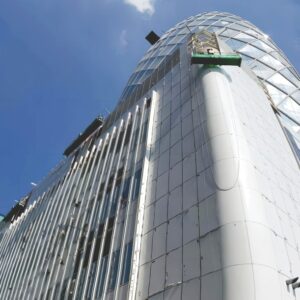Comprehensive Overview of Aluminum Alloy 5083

Introduction
Aluminum alloy 5083 is a commonly used alloy in the construction, transportation, and marine industries due to its excellent corrosion resistance, weldability, and formability. This article provides a comprehensive overview of the properties, applications, and limitations of aluminum alloy 5083.
Properties
Aluminum alloy 5083 is a non-heat-treatable alloy with moderate strength, good ductility, and excellent corrosion resistance. Its key properties are:
| Property | Value |
|—|—|
| Density | 2.69 g/cm³ |
| Melting Point | 630-650°C |
| Tensile Strength | 260-330 MPa |
| Yield Strength | 145-185 MPa |
| Elongation | 10-20% |
Composition
Aluminum alloy 5083 contains 95.3-97.0% aluminum, with the following alloying elements:
| Element | Weight % |
|—|—|
| Magnesium | 4.0-4.9 |
| Manganese | 0.7-1.2 |
| Iron | ≤0.4 |
| Copper | ≤0.1 |
| Silicon | ≤0.4 |
Applications
Aluminum alloy 5083 is widely used in the following applications:
- Construction: Roofing, siding, wall panels, window frames, and doors
- Transportation: Automotive body panels, truck trailers, and marine vessels
- Marine: Boat hulls, deck plates, and structural components
- Other: Heat exchangers, food packaging, and chemical processing equipment
Advantages
- Excellent corrosion resistance
- Good weldability and formability
- Moderate strength and ductility
- Lightweight and durable
- Non-magnetic and non-sparking
Limitations
- Lower strength than some other aluminum alloys
- Not heat treatable
- Can be susceptible to stress corrosion cracking in certain environments
Comparison with Other Aluminum Alloys
The following table compares the properties of aluminum alloy 5083 with other commonly used aluminum alloys:
| Alloy | Tensile Strength (MPa) | Yield Strength (MPa) | Elongation (%) |
|—|—|—|—|
| 5083 | 260-330 | 145-185 | 10-20 |
| 3003 | 140-170 | 100-130 | 20-30 |
| 6061 | 270-310 | 180-220 | 12-18 |
| 7075 | 480-570 | 420-500 | 12-18 |
Conclusion
Aluminum alloy 5083 is a versatile and widely used aluminum alloy with excellent corrosion resistance, weldability, and formability. Its moderate strength and ductility make it suitable for a wide range of applications in the construction, transportation, and marine industries. However, it is important to consider its limitations, such as lower strength than some other aluminum alloys and susceptibility to stress corrosion cracking in certain environments.
Forgeability:
Introduction
Forging, a metalworking process, involves shaping metal by applying compressive forces. It is a crucial process in various industries, including automotive, aerospace, and manufacturing. Forgeability, the ease with which a metal can be deformed and formed under forging conditions, plays a significant role in determining the suitability of a material for forging applications.
Hot and Cold Forging Processes
Forging processes are generally classified into two main types based on the temperature at which the metal is worked:
| Feature | Hot Forging | Cold Forging |
|:—|:—|:—|
| Temperature | Above recrystallization temperature | Room temperature to below recrystallization temperature |
| Strength | Lower | Higher |
| Precision | Less precise | More precise |
| Formability | Higher | Lower |
| Cost | Higher | Lower |
Hot Forging involves heating the metal to a temperature above its recrystallization point. This elevated temperature allows for easier deformation and improved formability, resulting in less force required for forging. However, hot forging can lead to increased oxidation and scale formation.
Cold Forging, on the other hand, is performed at room temperature or below the recrystallization point. While this results in higher strength and precision, it also requires greater forces due to the lower formability of the metal. Cold forging is often used for smaller and more precise parts.
Forging Characteristics and Properties
The forgeability of a metal depends on several factors, including its chemical composition, grain structure, and yield strength. Metals with high forgeability are generally characterized by:
- Low yield strength: This allows the metal to deform easily under pressure.
- Fine grain size: Smaller grains allow for more uniform deformation and reduced cracking.
- Low alloy content: Alloys tend to have higher yield strengths and reduced forgeability.
Properties of Forged Products
Forged products possess several advantages over other metalworking techniques:
- Enhanced Strength: Forging aligns the grain structure, resulting in higher strength and durability.
- Improved Grain Structure: The pressure applied during forging breaks down coarse grains, leading to a finer and more uniform grain structure.
- Increased Density: Forging closes porosity and removes inclusions, resulting in a denser and more homogenous product.
Examples of Forgeable Materials
Some of the most commonly forged materials include:
- Steel: Various grades of steel, including carbon steels, alloy steels, and stainless steels.
- Aluminum: Aluminum alloys are lightweight, corrosion-resistant, and highly formable.
- Copper: Copper and its alloys are known for their high electrical and thermal conductivity.
- Magnesium: Magnesium alloys offer high strength-to-weight ratios and good corrosion resistance.
- Titanium: Titanium alloys are strong, lightweight, and resistant to high temperatures and corrosion.
Conclusion
Forgeability is a critical factor in selecting the appropriate material and process for forging applications. By understanding the characteristics and properties of different metals, engineers can optimize forging parameters to produce high-quality, forged components with enhanced mechanical properties.
Machinability:
Introduction
Machinability is a critical parameter that governs the ease of machining a workpiece material. It encompasses various factors that influence the cutting process and the quality of the finished product. By optimizing cutting parameters and selecting appropriate tool materials, manufacturers can achieve efficient machining operations, minimize tool wear, and attain high-quality surfaces.
Cutting Parameters
Various cutting parameters play a significant role in machinability. These include:
- Cutting speed (v): The speed at which the cutting tool moves relative to the workpiece. Higher cutting speeds generally result in increased material removal, but also generate more heat and tool wear.
- Feed rate (f): The distance the cutting tool moves per revolution of the workpiece. A higher feed rate increases material removal rate but can lead to lower surface finish quality.
- Depth of cut (d): The thickness of the material removed in each pass. A larger depth of cut increases material removal rate, but increases cutting forces and tool deflection.
Tool Materials
The choice of tool material also impacts machinability. Common tool materials include:
- High-speed steel (HSS): A relatively affordable material with good cutting properties and durability. Suitable for a wide range of machining operations.
- Carbidetungsten Carbide (WC) and Titanium Carbide (TiC) are hard and wear-resistant, enabling high cutting speeds and long tool life.
- Diamond and Cubic Boron Nitride (CBN)**: Extremely hard and durable materials, suitable for machining hard materials like ceramics and exotic alloys.
- Ceramics: Provide high cutting speeds and excellent wear resistance, but are brittle and prone to chipping.
Machinability Ratings
Machinability ratings provide a quantitative measure of the ease of machining a material. These ratings are typically expressed on a scale from 1 to 100, with higher ratings indicating better machinability.
- Machinability ratings consider factors such as:
- Hardness
- Strength
- Ductility
- Abrasiveness
Finish Quality
Optimizing cutting parameters and tool materials is essential for achieving a desired surface finish quality. The following factors influence surface finish:
- Feed rate: A higher feed rate generally results in a rougher surface finish.
- Depth of cut: A larger depth of cut can lead to a wavy or uneven surface finish.
- Tool sharpness: A sharp tool produces a smoother surface finish compared to a dull tool.
- Tool material: Certain tool materials, such as ceramics, can produce excellent surface finishes due to their high wear resistance.
Table: Comparison of Tool Materials
| Tool Material | Cutting Speed | Wear Resistance | Cost |
|—|—|—|—|
| High-Speed Steel (HSS) | Medium | Good | Low |
| Carbide (WC, TiC) | High | Excellent | Medium |
| Diamond | Extremely High | Excellent | High |
| Ceramics | High | Excellent | Medium |
Conclusion
Machinability is a multi-faceted concept that involves optimizing cutting parameters and selecting appropriate tool materials to achieve efficient and high-quality machining operations. By understanding the factors that influence machinability, manufacturers can make informed decisions to enhance their machining processes, minimize costs, and elevate product quality.
Applications:
High-performance polymers (HPPs) are a class of materials that exhibit exceptional properties such as high strength, rigidity, resistance to wear and chemicals, and excellent thermal and electrical insulation. Their unique characteristics have made them indispensable in a wide range of industries, transforming products and enabling innovative applications.
Automotive and Transportation Components
HPPs have revolutionized the automotive industry by contributing to lightweighting, fuel efficiency, and enhanced performance. They are used in various components, including:
- Engine parts: Pistons, connecting rods, and valves benefit from the high strength and thermal stability of HPPs.
- Interior components: Dashboards, consoles, and seats incorporate HPPs for their durability, fire resistance, and aesthetic appeal.
- Exterior components: Bumpers, spoilers, and body panels are made from HPPs that provide excellent impact resistance and weatherability.
Marine and Shipbuilding Structures
HPPs are widely utilized in marine and shipbuilding applications due to their resistance to corrosion, harsh environments, and impact damage. They find use in:
- Boat hulls and decks: HPPs offer superior strength-to-weight ratio and resist water absorption, preventing decay and ensuring structural integrity.
- Marine equipment: Propellers, rudders, and masts benefit from the high-performance properties of HPPs, enabling efficient and reliable operation in marine environments.
Architectural and Building Materials
HPPs are making significant contributions to modern architecture and construction. They are employed in:
- Building facades: HPPs provide excellent resistance to UV radiation, weathering, and thermal expansion, enhancing durability and aesthetic appeal.
- Structural components: Beams, columns, and panels made from HPPs offer exceptional strength and rigidity, enabling efficient and lightweight structures.
- Roofing materials: HPPs are used in roofing membranes and shingles due to their durability, fire resistance, and UV protection.
Consumer Products and Electronics
HPPs are extensively used in consumer products and electronic devices because of their combination of strength, lightness, and electrical insulation properties. Applications include:
- Electronic housings: HPPs provide protection against impact, heat, and electrical interference, ensuring the reliability and performance of electronic devices.
- Appliances: Components such as gears, bearings, and seals in appliances benefit from the durability and wear resistance of HPPs.
- Medical devices: HPPs are used in medical implants, surgical instruments, and medical equipment due to their biocompatibility and resistance to bodily fluids.
Comparison of HPP Properties
The table below compares key properties of different types of HPPs:
| Property | PEEK | PEI | PSU | PPS |
|—|—|—|—|—|
| Tensile strength | 140 MPa | 110 MPa | 80 MPa | 100 MPa |
| Flexural modulus | 3.8 GPa | 2.6 GPa | 2.2 GPa | 2.3 GPa |
| Heat deflection temperature | 334 °C | 180 °C | 190 °C | 260 °C |
| Chemical resistance | Excellent | Excellent | Good | Good |
| Electrical insulation | Excellent | Excellent | Good | Good |
Conclusion
HPPs have become indispensable materials in a wide range of industries due to their exceptional properties and versatility. They enable innovative designs, enhance product performance, and contribute to the advancement of technologies. As research and development continue, the potential applications of HPPs are boundless, promising further advancements in various sectors.
Design Considerations:
Introduction
Design is a complex and multifaceted process that involves making decisions about a wide range of factors, both functional and aesthetic. Engineers and designers must carefully consider the impact of these choices on the overall performance, cost, and appearance of a product. This article explores some of the key factors that influence design choices, with a particular focus on the importance of strength-to-weight ratio.
Factors Influencing Design Choices
Numerous factors play a role in shaping design decisions. Some of the most important include:
- Function: The primary purpose of the product determines many design parameters, such as shape, size, and materials.
- Target market: The intended users of the product will influence design decisions related to aesthetics, usability, and affordability.
- Materials: The materials used in a product significantly impact its properties, including strength, weight, durability, and cost.
- Manufacturing processes: The methods used to manufacture a product can limit or enable certain design features.
- Cost: The cost of materials, manufacturing, and assembly are major factors that must be considered in design.
- Environmental impact: Increasingly, designers are considering the environmental impact of their products.
Strength-to-Weight Ratio Considerations
Strength-to-weight ratio is a critical consideration in many design applications. It measures the strength of a material relative to its density. A higher strength-to-weight ratio indicates that a material is strong for its weight.
Materials with high strength-to-weight ratios are often used in structural applications where strength and lightness are essential. Examples include:
- Aerospace: Aircraft and spacecraft require materials that are strong yet lightweight.
- Automotive: Race cars and high-performance vehicles benefit from the use of lightweight materials.
- Construction: Bridges and tall buildings use materials with high strength-to-weight ratios to ensure structural integrity.
Factors Affecting Strength-to-Weight Ratio
The strength-to-weight ratio of a material is influenced by several factors:
- Composition: The chemical makeup of a material has a significant impact on its strength and density.
- Heat treatment: Processes like annealing and tempering can alter the microstructure of a material, affecting its strength and weight.
- Geometry: The shape and thickness of a material can influence its strength-to-weight ratio.
Table Comparing Materials by Strength-to-Weight Ratio
| Material | Strength-to-Weight Ratio (MPa/kg/m^3) | Applications |
|—|—|—|
| Carbon fiber | 200-250 | Aerospace, automotive, sports equipment |
| Aluminum | 90-110 | Aerospace, automotive, construction |
| Titanium | 60-70 | Aerospace, medical implants, jewelry |
| Steel | 50-60 | Construction, automotive, infrastructure |
| Plastic | 10-20 | Consumer products, packaging, toys |
Conclusion
Design is a complex and iterative process that involves considering a wide range of factors. By carefully weighing the factors discussed in this article, engineers and designers can create products that meet the functional, aesthetic, and cost requirements of their intended users. In applications where strength and weight are critical, materials with high strength-to-weight ratios play a vital role in achieving optimal performance.
Specifications and Standards:
Specifications and standards are essential aspects of manufacturing operations, serving as a framework for product design, production, and quality assurance. By establishing clear guidelines, they enable consistent, high-quality products and facilitate communication throughout the supply chain.
Major Industry Standards and Certifications
- ISO 9001:2015 (Quality Management Systems): An international standard that sets requirements for a quality management system to ensure customer satisfaction, product quality, and continuous improvement.
- AS9100 (Aerospace Quality Management System): A specialized standard for the aerospace industry that incorporates ISO 9001 and industry-specific requirements for safety, reliability, and traceability.
- IATF 16949 (Automotive Quality Management System): A standard specific to the automotive industry, addressing product quality, safety, and environmental performance.
- IEC 61508 (Functional Safety of Electrical/Electronic/Programmable Electronic Safety-related Systems): An international standard for the design, development, and operation of safety-critical systems.
Compliance and Quality Assurance
Compliance with specifications and standards is crucial for ensuring product quality and meeting customer expectations. Quality assurance processes involve regular inspections, testing, and documentation to verify that products meet specifications. Common quality assurance methods include:
- Inspection: Physical examination of products to identify defects or nonconformities.
- Testing: Conducting controlled experiments to evaluate product performance and durability.
- Statistical Process Control (SPC): Using statistical techniques to monitor and control manufacturing processes, ensuring consistency and reducing defects.
- Audits: Formal assessments to evaluate compliance with standards and identify areas for improvement.
Benefits of Specifications and Standards
- Improved product quality and reliability
- Increased customer satisfaction and trust
- Reduced operating costs through efficiency gains
- Simplified communication and supply chain management
- Enhanced competitiveness and market share
Challenges in Meeting Specifications and Standards
- Cost of implementation and maintenance
- Complexity of standards and interpretations
- Lack of understanding or training
- Pressure to meet deadlines or reduce costs
- Technological advancements and changing requirements
Table: Comparison of Key Standards
| Standard | Scope | Certification Required |
|—|—|—|
| ISO 9001:2015 | Quality management systems | Optional |
| AS9100 | Aerospace quality management systems | Yes |
| IATF 16949 | Automotive quality management systems | Yes |
| IEC 61508 | Functional safety of safety-related systems | Yes |
Conclusion
Specifications and standards are essential tools for ensuring product quality and compliance in the manufacturing industry. By adhering to industry standards, manufacturers can enhance their processes, improve customer satisfaction, and gain a competitive advantage. Compliance with standards requires a commitment to quality assurance, ongoing training, and continuous improvement.





